The West Lake Scenic Area (西湖风景区) in Hangzhou covers a total area of 59.04 square kilometers, with the lake itself spanning 6.38 square kilometers and the surrounding conservation area spanning 35.64 square kilometers. Situated at the confluence of plains, hills, lakes, and rivers, with mountains on three sides and the urban area on one side, it is divided into five main areas: Lakeside, Lake Center, North Mountain, South Mountain, and Qiantang River.
Among its attractions, Gu Shan (Solitary Hill) is the largest natural island in West Lake. Su Causeway and Bai Causeway extend across the lake, while three artificial islands – Xiao Yingzhou, Hu Xin Ting, and Ruan Gong Dun – stand in the outer western part of the lake. Lei Feng Pagoda on Sunset Hill and Baochu Pagoda on Baoshi Hill reflect each other across the lake, forming the basic layout of “One Hill, Two Pagodas, Three Islands, Three Causeways, and Five Lakes.”
Visitors to West Lake can explore on foot, take a boat tour, ride electric cars, drive, or cycle. Electric cars are convenient and effortless, with tour cars readily available around the lake for a complete circuit. Cycling along the lake offers a romantic and leisurely experience, with several bike rental stations along the lakeside. Boat tours are another popular option, with nearly 10 docks offering various boats and routes.
Table of Contents
- Basic Information
- Location and Transportation
- Map of West Lake Scenic Area
- Highlights of West Lake Scenic Area
- Vlog about West Lake
- Other Iconic Attractions in Hangzhou
Basic Information
| Estimated Length of Tour | 1 – 2 days |
| Ticket Price | The admission for the West Lake is free, but you need to pay for some attractions around the lake, whose prices typically range from 10 RMB to 50 RMB |
| Opening Hours | 24 hours a day |
| Telephone Number | 0086-0571-87179617 |
Location and Transportation
The West Lake Scenic Area is located at 1 Longjing Road, Xihu District, Hangzhou City, Zhejiang Province, China. Situated in the western part of Hangzhou city, it is surrounded by mountains on the south, west, and north sides, while bordering the urban area to the east. The southern part is adjacent to the Qiantang River across the mountains. Because of the vast area of West Lake, there are several metro stations leanding there:
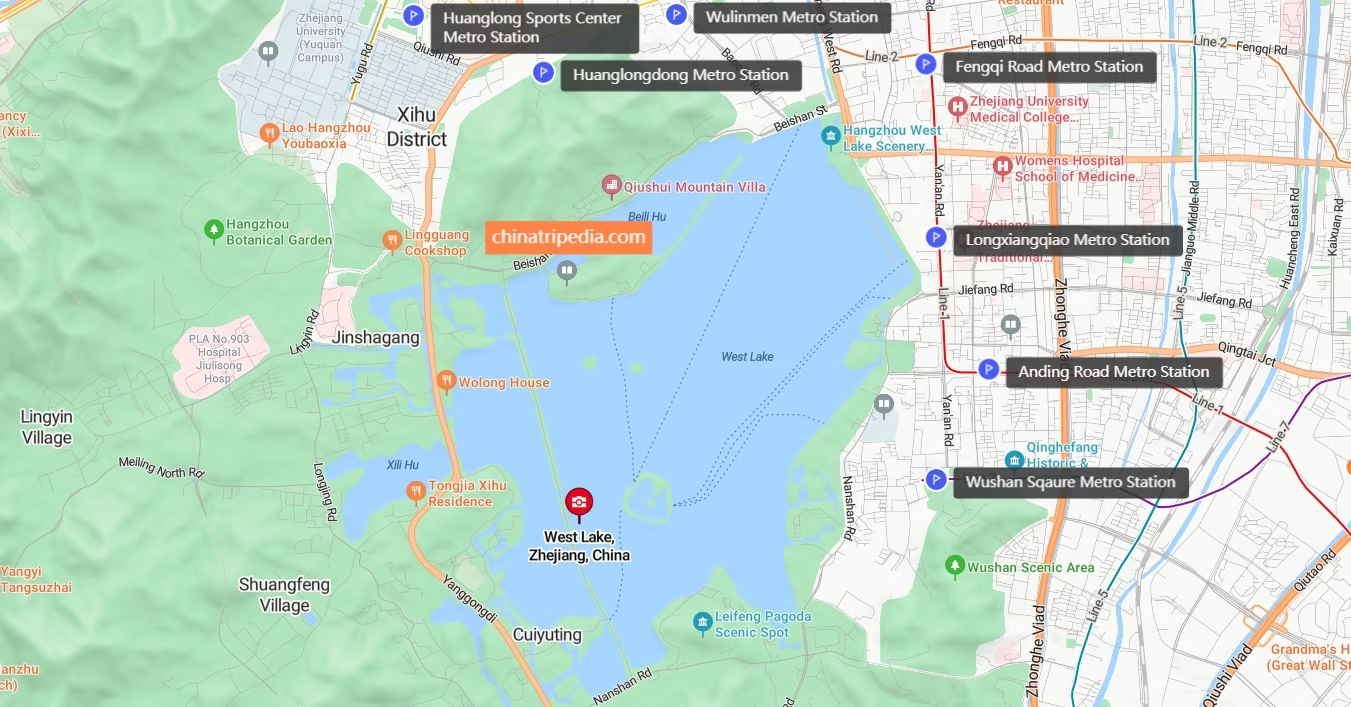
Longxiangqiao Station (龙翔桥), Line 1:
- Located closest to West Lake, it experiences high passenger traffic, especially during holidays like the May Day holiday.
- The station has four exits: A, B, C, and D. Exit B provides quick access to four parks on the east side of West Lake.
Fengqi Road Station (凤起路), Lines 1 and 2:
- Adjacent to the Wulin commercial area to the north, connected to West Lake Scenic Area to the west, and close to the Kerry Center.
- Acts as an interchange station for Lines 1 and 2. Exits C1, C4, C6, and D2 lead to Qiantang Gate Relics and are approximately 800 meters away. Nearby attractions accessible from the station include Beishan Street, Bai Causeway, the Broken Bridge, and the Wulin Night Market.
Ding’an Road Station (定安路), Line 1:
- Located east of the Southern Song Imperial Street, near the He Fang Street to the south, and close to the Wushan commercial area to the southwest, providing easy access to West Lake by walking westward.
- Exits B and C lead to Yongjin Park and West Lake Tiandi, approximately 700 meters away.
Wulinmen Station (武林门), Lines 2 and 3:
- Adjacent to the Hangzhou Traditional Chinese Medicine Hospital and the Zhejiang Provincial Government.
- Exits C and D lead southward along Huan Cheng West Road, about 1.6 kilometers to Beishan Street, the Broken Bridge, and Baiti.
Huanglong Sports Center Station (黄龙体育中心), Lines 3 and 10:
- Southwest is close to Zhejiang University’s Yuquan Campus, and to the east is the Huanglong Sports Stadium.
- Recommended for cycling, with exits B and D leading to various scenic spots around West Lake, such as Yuewang Temple, Quyuan Fenghe, Guo’s Villa, and Su Causeway, approximately 2.9 kilometers away.
Huanglongdong Station (黄龙洞), Line 3:
- Adjacent to Baoshi Mountain to the south.
- Exit C provides direct access to the Huanglong Cave scenic spot in West Lake. Exits A1, A2, and D lead to Beishan Street, the Broken Bridge, and Bai Causeway, approximately 2 kilometers away, while exits B and C lead to Yuewang Temple, Quyuan Fenghe, Guo’s Village, and Su Causeway, approximately 2.6 kilometers away.
Wushan Square Station (吴山广场), Line 7:
- Adjacent to Wushan Scenic Area, Hangzhou Museum, Wushan Bird and Flower Market, He Fang Street, Southern Song Imperial Street, and Chenghuang Pavilion.
- Exits C and D lead westward to the Liulang Wenying Park and further to Qianwang Temple, about 600 meters away.
Map of West Lake Scenic Area
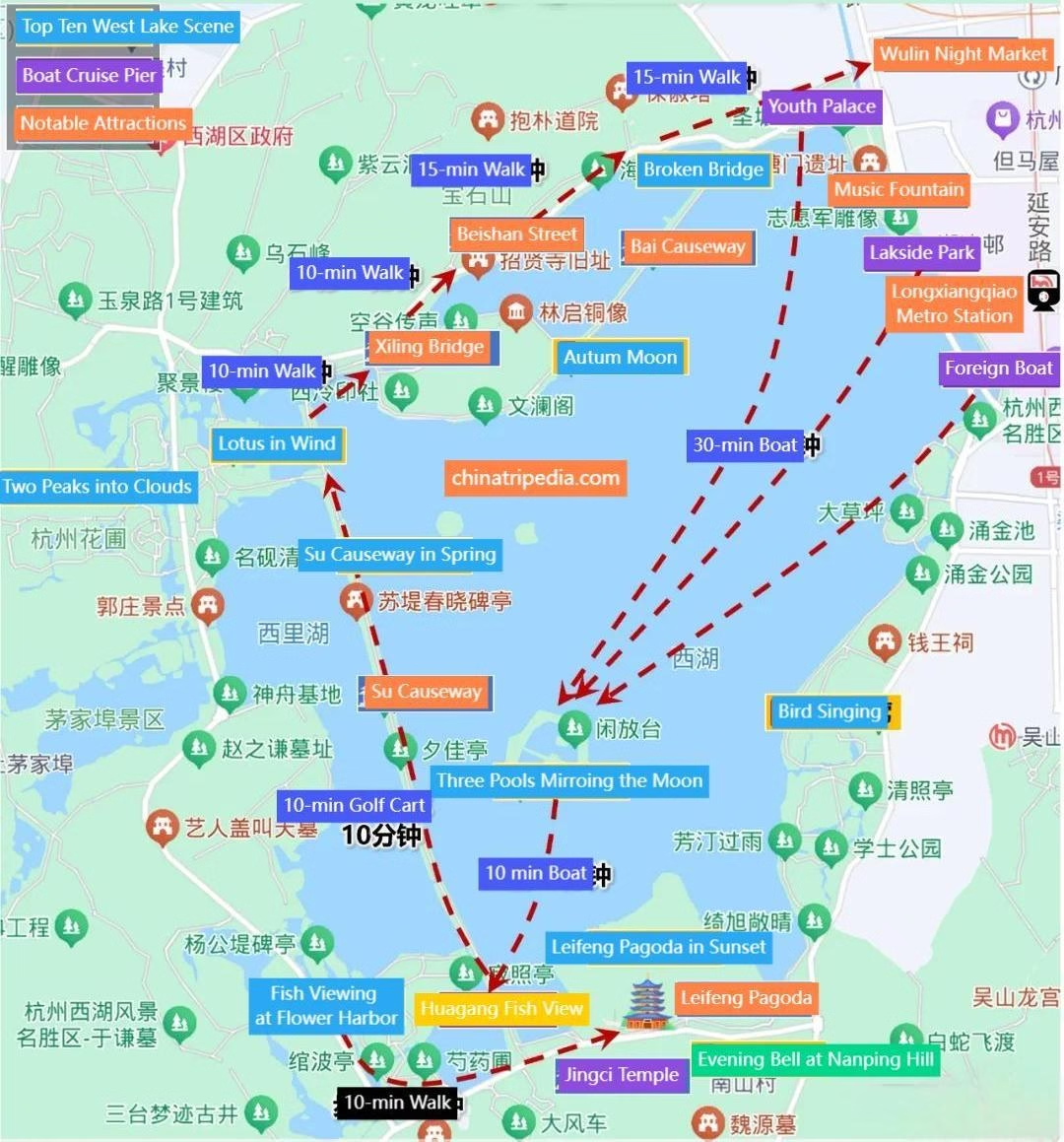
Highlights of West Lake Scenic Area
Attractions in the Northern Part of West Lake

Broken Bridge in Snow
Located at the eastern end of Bai Causeway, the Broken Bridge is one of the Ten Scenes of West Lake. After a snowfall followed by clear skies and sunrise, the snow on the bridge melts, revealing the brown surface underneath, creating a spectacular scene where the bridge seems to be broken.” Moreover, the Broken Bridge is associated with the romantic legend of Lady White Snake and Xu Xian, adding profound symbolism to the site.
Bai Causeway
Stretching from the Broken Bridge to the west to Pinghu Qiuyue, Bai Causeway is approximately one kilometer long. Lined with willow trees and vibrant peach blossoms, it offers an excellent vantage point to admire the beauty of West Lake. Jin Dai Bridge, located on Bai Causeway, is a significant landmark with its elegant and classical design, providing an ideal spot to enjoy the picturesque scenery of West Lake and Bai Causeway.

Pinghu Qiuyue (Autumn Moon Over the Calm Lake)
Situated at the western end of Bai Causeway, Pinghu Qiuyue is a popular spot for moon-viewing. The tranquil setting of Pinghu Qiuyue, with its serene lake, picturesque mountains, and pavilions, is particularly enchanting, especially on the night of the Mid-Autumn Festival when the bright moon hangs overhead, reflecting its radiance on the calm waters.
Baoshi Hill (Precious Stone Hill)
Located to the north of West Lake, Baoshi Hill features colorful sedimentary rocks, predominantly reddish due to the presence of iron oxide. When sunlight falls on the hill, it gleams brightly, resembling a precious gem embedded in the lake, hence the name. Baoshi Hill is complemented by the juxtaposition of Baochu Pagoda and Leifeng Pagoda across the lake, creating a picturesque scene often described as “Baochu resembling a beauty” and “Leifeng resembling a venerable monk.”

Huanglong Cave (Yellow Dragon Cave)
Also known as Wumen Cave or Flying Dragon Cave, legend has it that a monk named Huikai once built a temple and practiced asceticism here. One day, a dragon’s roar echoed from the cave, and a yellow dragon emerged from the clouds, hence the name Huanglong Cave. With its serene atmosphere and lush surroundings of pine trees and bamboo, Huanglong Cave features a pond with a mountain backdrop, creating a harmonious blend of water and rocks. Atop the cliff, a dragon’s head adorns the landscape, with water flowing from its mouth into the pond.
In addition to these attractions, the northern part of the West Lake Scenic Area also includes Yue Fei Temple, Solitary Hill, Fanghe Pavilion, Xiling Bridge, and the Tomb of Su Xiaoxiao, among many others, all worth visiting for their historical significance and natural beauty.
Attractions in the Western Part of West Lake

Yanggong Causeway
Located on the western side of West Lake, the Yanggong Causeway Scenic Area is a prominent highlight of the western part of the West Lake Scenic Area. Here, you’ll find numerous attractions such as the Spring Dawn on the Su Causeway, Hongli Mountain Villa, Sanyi Dreamland, and Wugui Pond. Among them, Spring Dawn on the Su Causeway is one of the Ten Scenes of West Lake, renowned for its charming spring scenery with willow trees swaying gently, peach blossoms in full bloom, and the picturesque lake and mountains in harmony. Hongli Mountain Villa is an elegant complex of ancient buildings known for its classical architectural style and beautiful garden landscapes, attracting numerous visitors with its tranquil ambiance.

Yuhu Bay
Yuhu Bay located on the southern side of the Yanggong Causeway, is a natural landscape where mountains and water complement each other. With winding lake waters and lush ancient trees, it offers an elegant environment for visitors to admire the beauty of the lake and mountains, experiencing a sense of tranquility and leisure.
Quyuan Fenghe (Lotus in the Breeze at Crooked Courtyard)
Another important attraction in the western part of the West Lake Scenic Area, Quyuan Fenghe is also one of the Ten Scenes of West Lake. It is famous for its lotus flowers, particularly during the summer when the lotus blossoms fill the pond with their fragrance, creating a picturesque scene. Additionally, the architectural style of Quyuan Fenghe is quite distinctive, with ancient pavilions and corridors complementing the lotus flowers, forming a beautiful picture.

Guo’s Villa
Guo’s Villa is a typical private garden in the Jiangnan style, renowned for its exquisite layout and beautiful garden landscapes. With its picturesque bridges, winding paths, and pavilions nestled among lush greenery, the scenery changes with each season. Visitors can savor the charm of Jiangnan gardens here and experience a sense of tranquility and leisure.
Longjing Tea Plantation and Longjing Spring
The western part of the West Lake Scenic Area is also famous for the Longjing Tea Plantation and the Longjing Spring. Longjing Tea, one of China’s top ten famous teas, is renowned for its unique aroma and flavor, attracting countless tea enthusiasts. Meanwhile, Longjing Spring is a clear and sweet spring water, said to be related to the Dragon King of the East Sea. With its excellent water quality, it is a source of pride for the people of Hangzhou.
Attractions in the Southern Part of West Lake

Liuhe Pagoda
Located on the Yuelun Hill, the Liuhe Pagoda is a prominent landmark in the southern part of the West Lake Scenic Area. This pagoda, originally built during the Northern Song Dynasty, stands 13 stories tall, though it only has 7 interior stories. The pagoda gradually tapers upwards, with 104 iron bells hanging from the eaves. When the wind blows, these bells chime melodiously, creating a serene atmosphere.
Nine Creeks and Eighteen Gullies
Situated amidst the mountains to the west of West Lake, Nine Creeks and Eighteen Gullies is a scenic area rich in natural beauty. Stretching from Longjing to Songcheng, this area features narrow mountain paths, lush vegetation, and murmuring streams, offering a tranquil and picturesque landscape. Visitors can stroll along winding mountain trails, admiring the natural scenery along the way and experiencing the serenity and harmony of nature.

Song Dynasty City
Song Dynasty City is a large theme park in the southern part of the West Lake Scenic Area, themed around the culture of the Song Dynasty, recreating the bustling scenes of the ancient city. Here, various performances such as “Song City Eternal Love” showcase the cultural charm and artistic beauty of the Song Dynasty. Additionally, Song Dynasty City features various entertainment facilities and specialty snacks, providing visitors with a fun and delightful tourism experience.
Yunqi Bamboo Path
Yunqi Bamboo Path is a secluded bamboo trail, renowned for its “green, clear, cool, and tranquil” bamboo scenery. Lined with bamboo groves, this path leads to the Yunqi Temple at its end. Visitors can stroll through the bamboo forest, experiencing the coolness and tranquility while enjoying the blessings of nature.

Hupao Park
Hupao Park is a mountainous garden park in the southern part of the West Lake Scenic Area, featuring Hupao Spring and Jigong Pagoda as its main attractions. Hupao Spring is known for its pure and sweet spring water, often paired with Longjing Tea as the “double excellence of West Lake.” Jigong Pagoda, built in memory of the eminent monk Jigong, boasts an elegant and harmonious blend with the surrounding natural environment. Visitors can savor the clear spring water, experience its refreshing sweetness, and appreciate the charm of ancient culture.


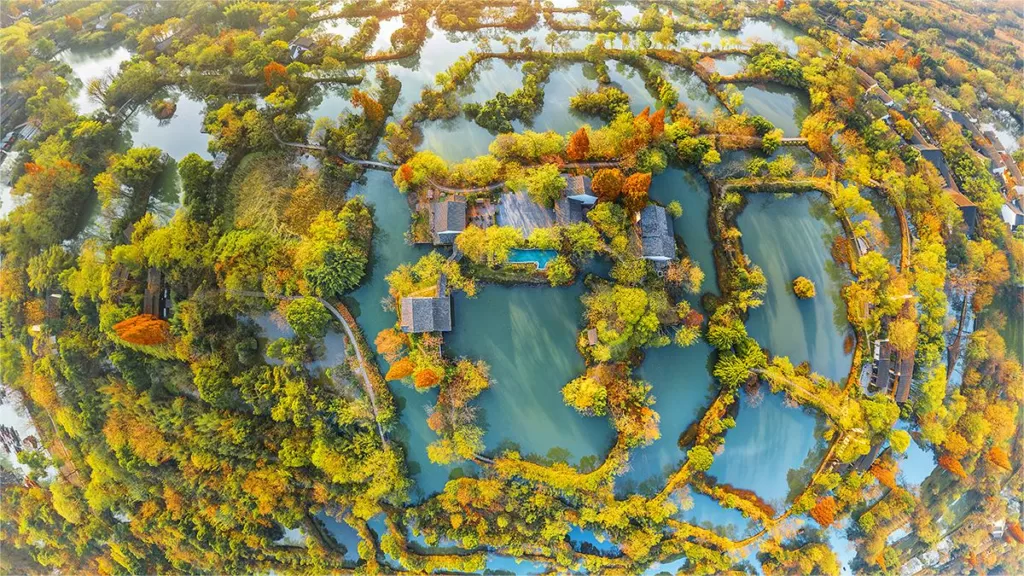
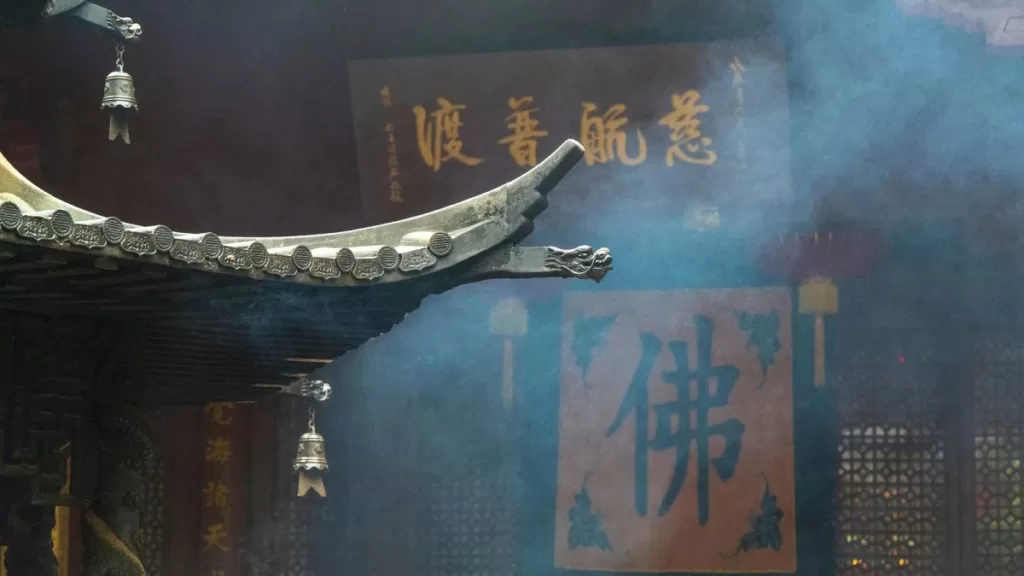
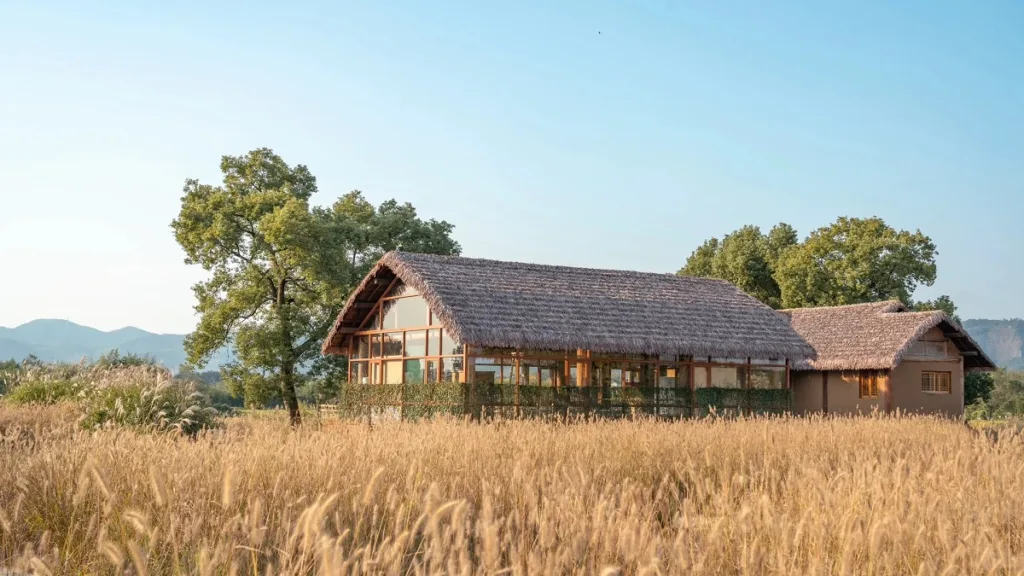


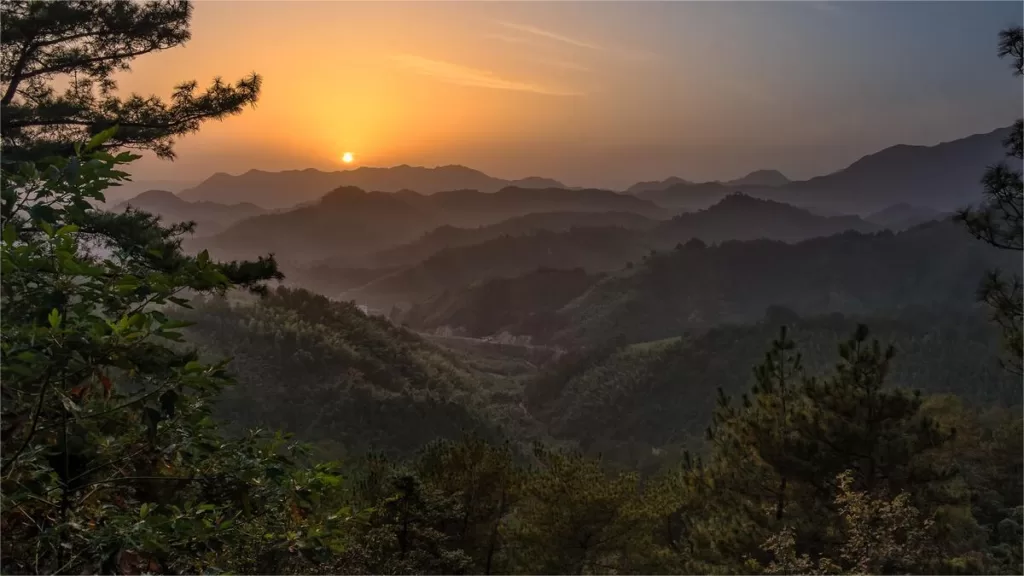

The breeze at West Lake in March is still a bit chilly… I have to complain about the weather at West Lake; it keeps alternating between rain, wind, and sunshine.